     Page 6. |
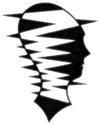 |
Nine ordering levels of a face in profile.
The information about nine-level physiognomic system is open
(free-of-charge) but nevertheless you must to pay 6 euro if you have such
opportunity. |
-
Physiognomic sphere of consciousness.
Ordering of a half-face by means of trigrams I Ching.
Except for six levels of a human face in profile in a context of physiognomy,
that is told on the previous pages in this section of website, it is possible to
consider nine levels of a half-face, namely it is possible to consider facial
shapes of a man by means of the nine-level physiognomic system according to
which the structure of human mentality corresponds with three physiognomic
spheres and nine levels of a face in profile.
For ordering of three physiognomic spheres and nine levels it is possible to
apply trigrams of the canon I Ching which can be compared to formal contours of
a human half-face, that is shown on the chart.
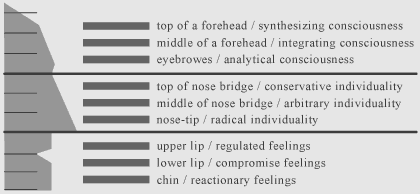 |
Each physiognomic sphere corresponds to one trigram,
and together three spheres of a human half-face correspond
to three trigrams of the canon I Ching. Everyone trigram I Ching consists of three lines which correspond with three levels in frameworks of each physiognomic sphere. If any level of a human half-face is increased then the appropriate line in trigram is strong (entire), and if a level of is reduced then the appropriate line in trigram is weak (break). The increased facial levels specify the expressed character traits, and the reduced facial levels specify the not expressed (latent) character traits. |
In total there are 8 kinds of trigrams in the canon I Ching and accordingly it is possible to
order 8 formal types for each physiognomic sphere of a human half-face. And
if to consider a human half-face as a whole, as set of three physiognomic
spheres, then there are 8x8x8=512 facial types according to the nine-level
physiognomic system.
Such ordering too big and consequently it is expedient to consider each sphere
separately, and then to make the general portrait of a person in a context of
physiognomy.
-
Physiognomic sphere of a forehead (consciousness).
The bottom level of a forehead (eyebrows) corresponds with analytical
consciousness and specifies features for decomposition of information or
knowledge as separate fragments, and specifies features for analyses of separate
fragments of information.
The middle level of a forehead corresponds with integrating consciousness
and specifies features for comparison of separate fragments of
information, and also specifies features for reflection about ratio of
fragments.
The top level of a forehead corresponds with synthesizing consciousness
and specifies features for connection of fragments of information in the
synthetic whole, that allows to generate ideas and images as the figurative
thinking arises when the isolated or opposite sources of information have unity.
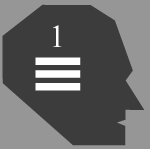
|
1st physiognomic facial type. Top of a forehead is expressed. Middle of a forehead is expressed. Eyebrows are expressed. All levels of a forehead are expressed, that means multipurpose mind which has analytical and integrating and synthesizing functions. Namely the man analyzes information according to analytical consciousness, and compares data fragments according to integrating consciousness, and also unites data fragments in complex systems according to synthesizing consciousness in view of physiognomy. Dark contours in the shown physiognomic images
designate symbolical forms of a human half-face, and white contours
designate formal reduction of sizes in comparison with the expressed
shapes, namely white contours correspond to weak lines in trigrams of
the canon I Ching. |
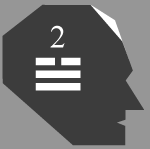
|
2nd physiognomic facial type. Top of a forehead is not expressed. Middle of a forehead is expressed. Eyebrows are expressed. Functions of synthesizing consciousness
are not significant but functions of analytical consciousness
matter, and also the man has features of integrating consciousness that
allows to analyze information and to compare data fragments. But the man does not unite
data fragments in
complex systems as it is not necessary for this type of mind in a
context of physiognomy. |
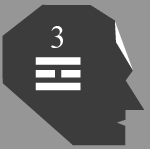
|
3rd physiognomic facial type. Top of a forehead is expressed. Middle of a forehead is not expressed. Eyebrows are expressed. The man has analytical and synthesizing
functions of consciousness, but is not capable to integrate results of
analytical reflections, and does not realize interrelation of mental
images which result from complex comprehension of information.
Namely the interrelation between figurative thinking and concrete
objects of analytical thinking is impossible, or otherwise it is
possible to tell that the man does not consider ratio of data fragments and does not realize interrelation according to which
data fragments of information incorporate in mental images, if to
analyze shapes of a face in a context of physiognomy. |
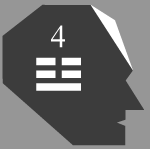
|
4th physiognomic facial type. Top of a forehead is not expressed. Middle of a forehead is not expressed. Eyebrows are expressed. The man has analytical functions of
consciousness but does not use features of integrating and
synthesizing functions. Therefore the man analyzes the
information but integration of data fragments and complex understanding
of information are not essential, if to look at facial shapes in view of
physiognomy. |
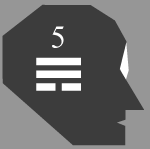
|
5th physiognomic facial type. Top of a forehead is expressed. Middle of a forehead is expressed. Eyebrows are not expressed. The man has integrating and
synthesizing functions of consciousness but analytical features are not
significant. Therefore the man creates mental images by means of
synthesis and by means of
integrating consciousness is capable to understand processes as a result
of which fragments of information incorporate and become a reason for
occurrence of mental images, but the man does not analyze separate
fragments of information, if to analyze a face according to concepts of
physiognomy. |
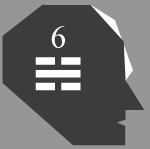
|
6th physiognomic facial type. Top of a forehead is not expressed. Middle of a forehead is expressed. Eyebrows are not expressed. The man has integrating mind
but functions of synthesizing and analytical consciousness are not
significant. Namely the man does not analyze separate fragments of
information and also does not create complex systems of mental images
with fragments, but realizes the information as set of fragments which can
be compared, but necessity for the systematized connections or
analyses of them are absent in view of physiognomy of a human face in
profile. |
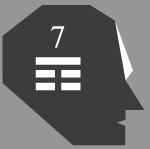
|
7th physiognomic facial type. Top of a forehead is expressed. Middle of a forehead is not expressed. Eyebrows are not expressed. The man has synthesizing consciousness
but does not give value to features of integrating and analytical
functions of mind. Therefore complex association of
information and synthesis of knowledge has the greatest value for the
man, and smaller value is at analyses of information and
understanding of the integrated ratios according to which data fragments
are interconnected. Namely the man realizes information as a complex systems which are not decomposed to
separate fragments and do not demand analytical understanding according
to concepts of physiognomy of facial profiles. |
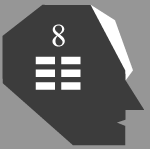
|
8th physiognomic facial type. Top of a forehead is not expressed. Middle of a forehead is not expressed. Eyebrows are not expressed. All physiognomic levels of a forehead
are not expressed. Functions of consciousness are not conducting
properties of the person in a context of physiognomy. |
It is conditionally possible to explain essence of analytical and integrating
and synthesizing functions of consciousness by means of the following allegory.
If to present fragments of knowledge or information as set of nuts then the analytical
consciousness splits nuts and investigates their contents. The integrating
consciousness compares grades (sorts) and the sizes of nuts. The synthesizing
consciousness systematizes nuts, and also unites grades and creates nuts with
new qualities.
In aggregate listed types of consciousness are capable to manipulate nuts and to
understand their properties according to analytical and integrating and
synthesizing predispositions of consciousness in the point of view of
physiognomy.
The first facial type carries out any realized manipulations with
nuts.
The second facial type splits the nuts and also realizes ratio of
their forms and versions of grades, but capabilities of connection of diverse
nuts in new forms is not meant.
The third facial type splits the nuts and reflects on capabilities of
existence of new unknown nuts, but this type does not reflect on ratio according
to which known nuts can be connected in new forms. Namely in consciousness there
are ideas about new qualities which nuts can have, but these ideas do not
associate with capabilities of connection of qualities which are realized as a result of
analytical research of known nuts.
The fourth facial type splits the nuts and investigates their
qualities but does not reflect on ratio of forms and grades, and also does not
think of probable combinations of different forms and grades.
The fifth facial type reflects on forms of nuts and unites forms in
new combinations without infringement of integrity of nuts and without
analytical understanding of their qualities.
The sixth facial type compares forms and does not think of contents
which is latent in shells of nuts, and also does not think about probable
combinations of forms and contents which are peculiar to different nuts.
The seventh facial type does not analyze the contents of nuts and does
not compare their form, but unites and reflects on the combined essence of
nuts.
The eighth facial type uses nuts and does not give value to
understanding of their sense.
The following page considers sphere of a nose and the appropriate facial levels of human individuality in frameworks of the nine-level system of physiognomy.
-